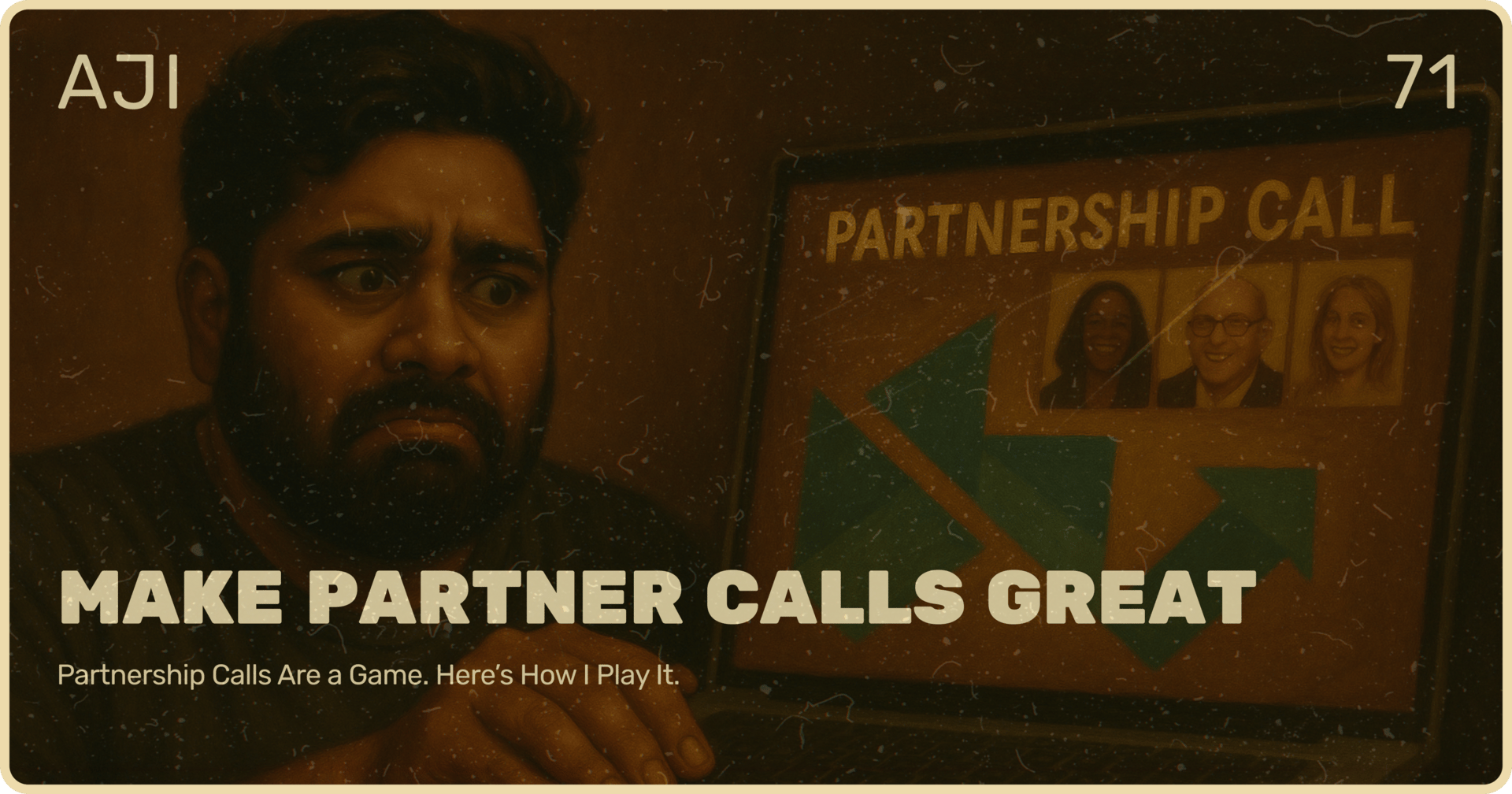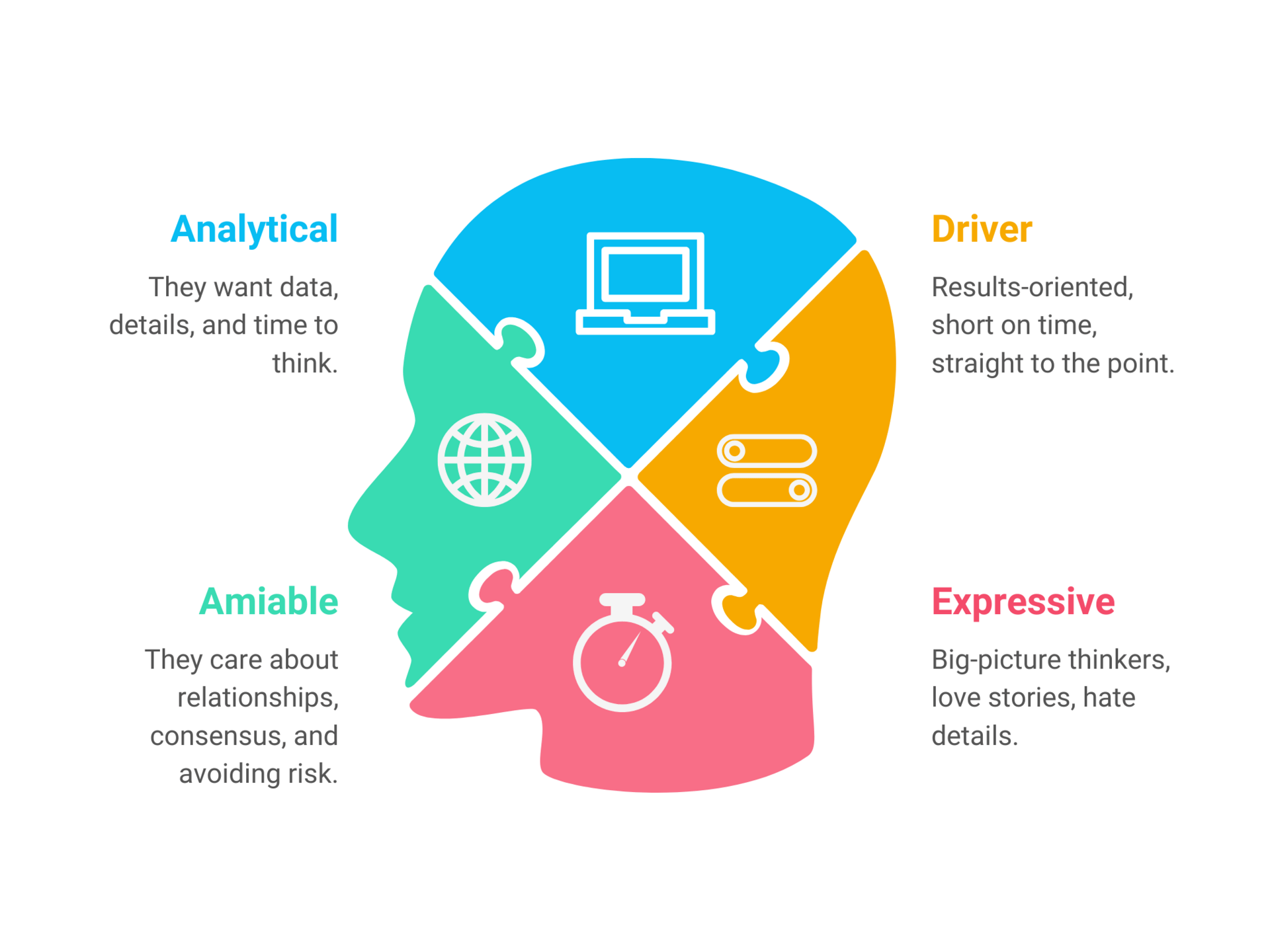- Ajay's Quest
- Posts
- Making Partner Calls Great
Making Partner Calls Great
Partnership Calls Are a Game. Here’s How I Play It.

I’ve done a lot of partnership calls — some great, some forgettable, and a few where I nearly shut my laptop mid-call.
I’ve spoken to Fortune 500 CEOs, politicians, YouTubers, even teenage startup founders. Along the way, I built a loose mental framework that helps make these calls more productive — and a little more human.
I shared this with a team member after a recent call, and figured I’d write it up for anyone else navigating the same waters.
Here are a few frames that have helped me.
Who’s on the other side of the table
Before I talk tactics, I try to get a read on the person. What type of human am I dealing with? I loosely map them to one of these four temperaments:

It’s not a perfect system, but it’s directionally useful. I adjust my tone, pacing, and approach based on where I think someone lands.
Don’t fully bucket them — most people are a mix. But these patterns give you strategic cues to play with. A lot of it comes from experience, but you can often tell based on a few behaviors:
🔵 Analytical
Telltale signs:
Asks comparative questions (e.g. “How does this compare to X?”)
Pushes for time to think before committing
Asks lots of clarifying or technical questions
May use a cautious or skeptical tone
Pauses before responding
Strategy: Slow down. Give them data. Let them process. Don’t try to “close” them too quickly — they’ll bounce if they feel pressure.
🟠 Driver
Telltale signs:
Opens with “What’s the bottom line?” or “What do you need from me?”
Wants to move fast and cut through details
Interrupts to steer the conversation
Comes off as blunt or impatient
Values control and clarity
Strategy: Lead with outcomes. Be direct. Have a clear ask early. Don’t waste their time with context they didn’t request.
🟢 Amiable
Telltale signs:
Asks how it’ll impact the team or relationships
Uses softer language (“just wondering,” “we were thinking…”)
Hesitates to disagree directly
Frequently says “we” instead of “I”
Smiles or nods to keep the energy positive
Strategy: Start with rapport. Show how your proposal helps people, not just metrics. Make it feel safe, collaborative, and non-pushy.
🔴 Expressive
Telltale signs:
Uses vision-driven language (“Imagine if…”)
Tells stories or goes on tangents
Talks quickly and with emotion
Easily distracted by new ideas
Avoids diving into the weeds
Strategy: Match their energy. Pitch with narrative and vision. Don’t overload them with complexity — they want inspiration, not spreadsheets.
Where do I fall? Depending on the topic, I bounce between Driver and Analytical. If you’re pitching me a sponsorship deal, I’m all Driver — get to the point, tell me the outcome, and let’s move. But if it’s something I’m less familiar with, I’ll slow down, ask questions, and dig into the details.
The Peak End Rule
Ever had someone DM you, “That meeting was actually awesome”?
I have — and it usually comes down to one thing: how it ended.I’ve had it a few times and every time it came down to how I ended the meeting.
People rarely remember the whole call. What sticks is the emotional high point — and how it ended. That’s the Peak-End Rule in action. The peak might be a shared laugh or breakthrough idea (often out of your control).
But the end? That’s yours to own.
Here’s how I try to close strong:
Clear next steps – so there’s no confusion.
Genuine enthusiasm – even if the call wasn’t great.
Gratitude – people remember how you made them feel.
A memorable phrase, story, or joke – something to leave a good aftertaste.
I actually wrote a whole piece on how to run internal meetings — and a lot of those lessons carry over to external calls too.
Humour is a cheat code
Most business calls are dry. Formal. Forgettable.
But if you can make someone laugh — even just once — you cut through the stiffness instantly. It’s a shortcut to trust. A shared moment that makes the call feel less like a transaction and more like two humans trying to figure something out.
You don’t need to be a comedian. Just be a little more human than expected.
A well-timed joke, a self-aware comment, or even a playful analogy can shift the tone of the whole conversation.
WIIFT (What’s in it for them?)
This is the golden rule.
I spend most of the call trying to figure out what they actually want — not what they say they want, but what’s underneath it.
Are they…
Trying to impress their boss?
Chasing a quarterly target?
Looking to associate with something “cool” and innovative?
Trying to avoid risk or change?
If I can pinpoint that core driver, everything gets easier. I stop selling features. I start solving their actual problem.
And often, they won’t even tell you outright. You have to listen between the lines.
Final Thoughts
A good partnership call doesn’t always end in a deal. But it should always end with clarity, goodwill, and momentum.
And if nothing else, at least make it a little less boring than the last one on their calendar.
Until next time,
Ajay
🧠 Ajay’s Resource Bank
A few tools and collections I’ve built (or obsessively curated) over the years:
100+ Mental Models
Mental shortcuts and thinking tools I’ve refined over the past decade. These have evolved as I’ve gained experience — pruned, updated, and battle-tested.100+ Questions
If you want better answers, ask better questions. These are the ones I keep returning to — for strategy, reflection, and unlocking stuck conversations.Startup OS
A lightweight operating system I built for running startups. I’m currently adapting it for growth teams as I scale Superpower — thinking about publishing it soon.Remote Games & Activities
Fun team-building exercises and games (many made in Canva) that actually work. Good for offsites, Zoom fatigue, or breaking the ice with distributed teams.
✅ Ajay’s “would recommend” List
These are tools and services I use personally and professionally — and recommend without hesitation:
Athyna – Offshore Hiring Done Right
I personally have worked with assistants overseas and built offshore teams. Most people get this wrong by assuming you have to go the lowest cost for automated work. Try hiring high quality, strategic people for a fraction of the cost instead.Superpower – It starts with a 100+ lab tests
I joined Superpower as Head of Growth, but I originally came on to fix my health. In return, I got a full diagnostic panel, a tailored action plan, and ongoing support that finally gave me clarity after years of flying blind.
(Want a discount code? Just reply to this email.)